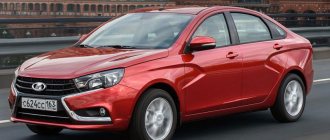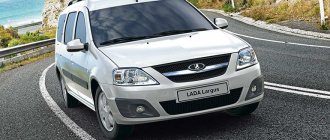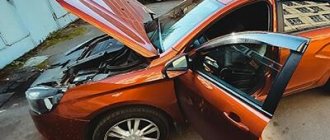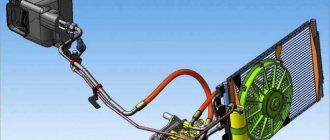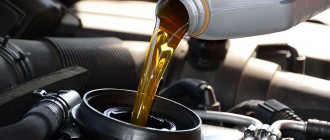A domestically produced SUV rolled off the assembly line in Togliatti in 2002. High cross-country ability, unpretentiousness, ease of repair and relatively low fuel consumption made it a sales star in the CIS countries. At the same time, the VAZ-2123 engine changed the ECM several times - the Euro-2 standard gradually changed to Euro-5. Paradoxically, with each such “update” the car consumed more and more gasoline. Let’s figure out what fuel consumption the Chevrolet Niva has per 100 km now (according to the passport and in fact), and find out how to reduce it.
Specifications
Chevrolet Niva has been produced since 2002. The model is based on a VAZ-2123 engine, volume 1.7. There is an independent 2-link front suspension. At the rear there is a continuous bridge. Since this is an SUV, it comes with all-wheel drive. The transfer case distributes torque between the front and rear axles in equal proportions - 50/50.
Increased cross-country ability is facilitated by a lowering row, the presence of an inter-axle locking mechanism and well-executed body geometry. The car moves comfortably both in off-road conditions and on the highway in the city.
The modification on a VAZ engine is characterized by the following parameters:
- Gas engine;
- piston stroke – 80 mm;
- number of valves – 8.
The average gasoline consumption is 10 liters per 100 km. Feature - in urban highway conditions there is an increase in consumption to 13.2–14.2 liters.
Fuel consumption of Niva Chevrolet per 100 km according to the passport
According to the documentation, the Niva Chevrolet has the following gasoline consumption per 100 km:
- city (road, highway) – 14.1 l;
- highway - 8.8 l;
- the average is 10.2 liters.
This characteristic is valid for an engine with the Euro-5 environmental standard, volume 1.7. For modification 1.8 with a similar European standard, a decrease in consumption is noted .
Gasoline is consumed in the following quantities:
- city - 12.7 l;
- highway - 10.4 l;
- the average is 8 liters.
If the owner notices an increase in consumption or is dissatisfied with the performance of the devices, then you need to find out the reason, then contact the service center.
What affects fuel consumption
Fuel consumption increases and decreases depending on driving style. This parameter is also affected by the selected road (rough terrain, city highway, highway). Consumption indicators increase in proportion to the weight of the machine. For the Chevrolet Niva, this figure is 1.5 tons with a compact body. In the restyled model, consumption was reduced to 1.4 liters.
Dynamic characteristics also affect fuel consumption. The injector helps save gasoline.
Option 3 of 4: Driver Habits
1. Use cruise control driving technique. This often helps save fuel while maintaining a constant speed.
Also interesting: How to remove the rear axle gearbox of a VAZ 2121 Niva 2131
2. Don't rush. As the speed increases, the resistance of the oncoming air flow also increases. When driving at higher speeds, fuel consumption increases by up to 30%. At a speed not exceeding 60 km/h, the effect of air resistance on fuel consumption is practically non-existent, and at higher speeds it becomes more significant.
3. Sharp accelerations are very harmful. Internal combustion engines have an optimal operating mode at 2000-3000 rpm, and the greatest power develops at 5000-6000 rpm. When the engine reaches the required speed, you need to switch to the next gear using a manual gearbox.
For example, to accelerate a car to 50 km/h, you turn on the first, accelerate on the second, and then, skipping the third, turn on the fourth or fifth, provided the engine maintains speed. But you need to remember that when you press the gas pedal in fifth gear at low speed, there will be no acceleration. In this case, you can switch to a lower gear.
4. Try to brake as little as possible, because for subsequent acceleration you will use up fuel that could be saved. Carefully monitor the operation of traffic lights to avoid unnecessary acceleration.
5. You should not warm up the car while idling. It is better to do this by starting slowly, avoiding jerky accelerations until the engine reaches the required temperature.
6. Decide on the optimal speed in relation to the amount of fuel consumed. Often this is 80 km/h. Optimal speed involves minimum speed in maximum gear. For example, the optimal speed for Jeep Cherokees is 90 km/h, and for Toyota 4Runners is 80 km/h. Determine the optimal speed of your car, try to stick to this speed when traveling.
7. Some cars are equipped with gearboxes that have an “overdrive” function. If your car is one of those equipped with this device, turn it on in a timely manner. In some cases, turning it on is inappropriate, for example, when towing a large load. The “overdrive” function is considered to be turned on by default when the gearbox lever is in the “D” position. In some cars, this function is turned off with a button. But it can turn off when the engine brakes while moving down, or, conversely, when going up. This feature contributes to slight fuel savings by allowing you to maintain speed at low engine speeds.
8. Carefully observe the operation of traffic lights. Sharp acceleration and braking do not have the best effect on the Niva’s consumption. You shouldn’t circle around the parking lot for a long time, burning fuel, to choose a more convenient place. You have to accept that the most convenient seats are always occupied.
9
Maintaining a safe distance is very important. Driving at a short distance forces you to brake and accelerate much more often than driving 20 meters at the same speed.
You will gain time for braking at traffic lights, you will have to brake significantly less in connection with the car in front, and you will also have the opportunity to maneuver.
10. Long-term heating has an adverse effect on Niva consumption. In the cold season, 30 seconds is enough to warm up the engine. During this time, the engine is already sufficiently lubricated for safe operation. If you stop for more than 10 seconds, turn it off. This will also help save fuel. But keep in mind that if you start the engine frequently, you will damage the starter.
11. Decide on the gear that is most suitable for uniform movement. When driving lightly on the highway, you can resort to the highest gear. Listen carefully to the operation of the engine, since driving in a high gear is fraught with malfunctions in insufficiently powerful engines. Some manufacturers offer various versions of the gear ratio in the gearbox.
Also interesting: Engine 21214 Features, characteristics and tuning
Fuel consumption per 100 km Chevrolet Niva
Fuel consumption depends on many factors, such as driving style, operating conditions, engine wear, as well as other components and assemblies. Also, fuel consumption will be different due to different modifications of the installed power plants.
Let's consider the consumption under various operating modes on the Chevrolet Niva model. We will summarize all official data in a table with characteristics.
This model began production in 1998 and remains popular to this day:
- Chevrolet Niva (Generation 1 – 1998-2009; Generation 1 Restyling – 2009-present).
Along the highway
In practice, the highway driving mode for the Chevrolet Niva is the most economical driving option. This is also reflected in the passport characteristics declared by the manufacturer for this car.
But it is worth considering that fuel consumption according to the passport will differ from consumption in real conditions. Factory tests create ideal conditions and maintain optimal engine speed and rpm.
In the city
Driving around the city in a Chevrolet Niva is the most expensive mode in terms of fuel consumption. And real data may differ very much from the reference data set by the manufacturer.
Driving a car with sudden accelerations, frequent idle times at traffic lights, or in hours-long traffic jams do not contribute to fuel economy. As, indeed, are frequent trips over short distances made during the day.
If you exclude these factors, and also stick to a calm ride with smooth acceleration and braking. It is quite possible to meet the figures stated by the manufacturer, shown in the table below.
Medium (mixed cycle)
The average fuel consumption of the Chevrolet Niva implies driving a car in urban and suburban cycles. This is what people pay attention to when choosing a vehicle, as well as when taking into account expenses.
But the mixed cycle, like those given above, in real conditions may differ from the reference ones indicated by the manufacturer. Therefore, you should not rely on them fully.
Usually, experienced drivers, in order to get more realistic figures, advise adding 10-15% to the consumption indicated in the passport specifications.
Appetite for the Euro 5 era
The current sample for testing is the luxury LEM package. Complete mincemeat with an off-road bias, which means a heavier car compared to the base model with toothy off-road tires. Plus modern environmental standards that stifle the already weak engine. You shouldn't expect much speed here. It’s not there - fighting fast trucks is still not easy.
But in some moments it became a little easier, in others - a little harder.
I got used to it pretty quickly. In order not to delay acceleration at all, I time the shifts so that when switching to higher gear, the speed drops no lower than 3200 rpm. Then the “drawdowns” when accelerating are minimal.
The whole set of sensations associated with the response to the gas pedal indicates a new engine management program. Why didn't they warn you at the factory? Over many years of acquaintance with factory specialists, we have developed an unspoken agreement: on some items, we will share our impressions after a test drive. In some cases, innovations are easier to perceive with a head that is not clouded by unnecessary knowledge. The program is just a program!
I stop at the nearest gas station, fill up under the traffic jam and make notes in the logbook - it’s time to estimate the fuel consumption by topping up to a full tank.
What happened in the busy Chelyabinsk with repairs, difficult terrain and overtaking trucks? Quite decent 8.8 liters per “hundred”. This is a pure track with speeds of 85–110 km/h. Mixed mode with off-road crawling, air conditioning on, cold starts and long idling during photography gave 9.5–10 l/100 km, which is quite economical for a Niva.
But Niva presented the main surprise a little later on the Baltic highway. I have a section on the M9 for estimating fuel, where you can guess the time of day and day of the week to get an average speed of about ninety with peak values of no more than 110 kilometers per hour. There, in New Riga, Niva produced a record 8 l/100 km. Moreover, I did not engage in tedious “sawing” for the sake of advanced indicators. I drove 100–105 km/h, and overtook in narrow sections, without hesitation to press the gas.
General impression of the modernized program? It doesn't cause any problems in a city traffic jam. And on the highway, those minor inconveniences that only an experienced Niva fan will notice will more than pay for the hitherto inaccessible fuel efficiency. And it seems that this is the maximum that can be extracted from an elderly engine in factory conditions, taking into account environmental standards.
LPG consumption
Installing gas equipment allows you to save a lot of money. Of course, gas consumption increases by 10-20%.
You should not trust the installers and hope that fuel consumption will remain at the same level. However, the increased consumption is offset by half the price of propane.
As a result, the cost of 100 km is reduced by 30-40%.
And the less economical your engine is, the more profitable it is to install gas equipment on it.
But we must not forget about the disadvantages of HBO:
- Additional costs for installation and maintenance of gas equipment.
- Reducing the usable volume of the trunk.
- Slight increase in vehicle weight.
As for mileage, the situation is ambiguous. A Chevrolet Niva will travel more on a full tank of gasoline than on a propane tank. But when refueling both types of fuel, you will get an additional 300 km until the next refueling.
Examples of savings in Moscow
For example, let's calculate two distances:
- From Red Square to the Moscow Ring Road and back in Moscow 50 km. How much gas does one save per month of such trips?
- From Moscow to Sochi - 1600 km. How much cheaper will it be to fill up with gas?
Savings after installing HBO
| Volume | Transfers | From Red Square to the Moscow Ring Road and back × month | From Moscow to Sochi and back | ||||
| Petrol | Gas | Saving | Petrol | Gas | Saving | ||
| 1.7 | Mechanics | 5 613 ₽ | 3 071 ₽ | 2 542 ₽ | 11 974 ₽ | 6 551 ₽ | 5 424 ₽ |
| Prices for a liter of gasoline and gas: 95 - 37.42 ₽, CIS - 18.61 ₽. | |||||||
If you spend more than an hour a day driving a Chevrolet Niva, then gas equipment will pay for itself in less than a year. Calculate your monthly and annual savings on your mileage using the savings calculator.
Share with your friends how much they can save:
Fuel consumption indicators
Gasoline consumption of this car ranges from 9 liters per 100 kilometers to 15.
Fuel consumption on the Chevrolet Niva in the city is 9 liters, on the highway - 11, in mixed mode 10.6 liters. But, as real owners of these cars say, fuel use is approximately 14 - 15 liters, it does not decrease, depending on the route, or the fluctuations are insignificant. Most of the gasoline consumption on the Niva 212300 comes from speed and driving habits. Despite all this, it is worth noting several huge advantages:
- high cross-country ability of an SUV;
- four-wheel drive;
- favorable pricing policy;
- quickly develops speed.
It is almost impossible to get a steel horse with all-wheel drive at this price, because prices for them start at the same point where prices for Chevrolets already end.
The question of the profitability of a car is always very acute, because not everyone can afford such costs for fuel or an expensive car. Therefore, the developers made a rather smart move by creating a budget option that is accessible to everyone. Of course, no company has yet managed to create the ideal car, but the price of this model fully corresponds to the quality.
What is the actual consumption in the city and on the highway?
If you fully load the trunk or add a trailer, the consumption will increase to 2 liters per 100 km (taking into account that there is a driver and 1 passenger in the cabin).
Low dynamics appear if you reduce gasoline consumption. In this case, acceleration to “hundredth” will take 19 seconds. The maximum speed will be 140 km/h.
Fuel consumption will be more economical if you change driving modes. On the highway it’s about 10 liters, while quiet city driving will require 12-13. If you choose mixed modes, you can achieve figures of 11 l/100 km. Feature: in this case, oil consumption increases.
Mileage without refueling before installing LPG
Let's look at the size of the Chevrolet Niva fuel tank for gasoline and the most common size of the installed gas cylinder.
Chevrolet Niva tank, autonomous mileage
| Volume | Transfers | Tank capacity | Refilling the tank | Autonomous mileage on a full gas tank | ||
| In the city | On the road | Mixed | ||||
| 1.7 | Mechanics | 58 l. | ||||
| Gas tank capacity in liters. Gasoline price in rubles per liter: 95 - 37.42 rubles. | ||||||
Fuel consumption
One of the most discussed topics among car owners is: what is the fuel consumption of the Chevrolet Niva? Let's figure it out. Consumption depends on many parameters, both on the characteristics of the car itself and on its operating conditions. Each specific car will always have its own, but there are fuel consumption standards set by the manufacturer. They are presented below, per 100 km.
Consumption of Chevrolet Niva 1.7 l Euro-2
- urban mode - 10.8 l
- highway consumption (5th gear, speed 90 km/h – 8.6 l
- highway consumption (5th gear, speed 120 km/h) – 11.6 l
Consumption of Chevrolet Niva 1.7 l Euro-5
- urban mode - 14.1 l
- highway consumption – 8.8 l
- average consumption – 10.2 l
Interestingly, the updated engine with the Euro-5 environmental standard has increased fuel consumption, but its power has remained unchanged.
Consumption of Chevrolet Niva 1.8 l
- urban mode - 12.7 l
- highway consumption – 10.4 l
- average consumption – 8 l
Modifications
Chevrolet Niva (212300 - 55) first rolled off the production line back in 2002 and immediately gained popularity among drivers thanks to its good cross-country ability, powerful engine, reliability and low maintenance costs.
In its entire history, the car has experienced only one restyling in 2009 a modern appearance.
Niva Chevrolet 1.7 l
The heart of the Chevy Niva is the VAZ-2123 four-cylinder gasoline engine , developed on the basis of the VAZ-21214 injector back in the 90s of the last century.
Technical characteristics VAZ-2123 engine :
- volume - 1.7 liters
- power - 80 hp
- torque - 127.5 Nm (at 4000 rpm)
- maximum speed - 140 km/h
- Acceleration time to 100 km - 19 seconds
The engine was updated and improved several times, was modified and transferred by designers from the Euro-2 environmental standard to modern Euro-5 standards.
Since the end of 2015, all cars have been produced only with a Euro-5 class engine.
Niva Chevrolet 1.8 l
FAM-1 (VAZ-21236) was produced from 2006 to 2008. 1.8- liter Opel Z18XE .
Its technical data was superior to the VAZ engine:
- volume - 1.8 liters
- power - 122 hp
- torque - 167 Nm (at 3800 rpm)
- maximum speed - 165 km/h
- acceleration time to 100 km - 12 sec
The cost of the Chevy Niva in this configuration was much higher, so it was not in great demand, and in less than two years it was withdrawn from the market. However, such fields still travel safely on the roads of the country.
Increased fuel consumption on a Chevrolet Niva
The reality is that fuel consumption specifications are difficult to achieve. This is repeatedly confirmed by reviews. This situation is typical for all cars.
Reasons for data discrepancy:
- A fully functional machine is required;
- the road must be of ideal quality;
- presence of a smooth driving style;
- refueling with ideal quality gasoline;
- absence of head or side wind during measurements.
The weather factor also affects consumption. In winter, consumption increases by an average of 15%. Heating the motor increases consumption by another 10%, and when moving a short distance up to 20%. The same applies to driving for a short time with pre-warming.
How to reduce gasoline consumption?
There is unlikely to be a noticeable effect:
- From the use of “chemistry” (additives);
- From installing all kinds of “magnets”, etc.;
- Switching to “synthetics” (for example, 5W40) is a radical method, but not recommended;
- From the transition to AI-92, “liter consumption” increases slightly, consumption in rubles decreases.
To improve efficiency, you need to properly configure the transmission. People usually talk about balancing cardans, but know that imbalance can only occur as a result of deformation. There is no need to pay money for an almost useless procedure. However, let the owner make the final choice.
Balancing and correct installation of the RC
Everything is clear with shaft balancing, but other elements are usually not thought about.
Transfer case and two shafts
Make sure you meet the following requirements:
- The transfer case (RK) is installed so that the axis of the gearbox shaft and the primary axis of the RK meet at a point coinciding with the center of the CV joint (see drawing). Also, the steering wheel must be centered: each secondary shaft must be parallel to the bottom and directed strictly along the body.
- The crosspieces should turn easily, and, moreover, with the same force!
- Avoid play in splines, crosspieces and secondary shaft bearings.
The tighter the crosspiece rotates, the more the steering wheel can deviate on its “pillows”. This results in noticeable energy losses.
The crosspieces are located inside the anthers
Subtleties of diagnosis
By looking at the noise spectrum, you can find out what exactly is making noise. Let the rotation speed be N. Then:
- Only one of the crosses can produce a sound with a frequency of 2N;
- The secondary shaft of the RK will make noise with frequency N.
Common problem
Often the knock sensor on the 2123 engine fails. When installing it, it is “tightened” - the tightening torque should be 18 N*m.
Replacing the sensor
You just need to take it and replace the DD. Suitable options:
- 21120-3855020-00, -01, -02, -03;
- Fenox SD10100O7;
- BOSCH 0 261 231 046.
There will be two problems:
- The DD on the VAZ-2123 is accessible only from under the bottom (remove the lower panels);
- The ECM does not recognize the new sensor immediately, but after 20-30 km of “break-in”. Like this.
We wish you success.
Screen, camera, socket
Generally speaking, Niva came from Togliatti to test the multimedia systems of domestic all-wheel drive vehicles. Yes, yes, it has a color screen and accompanying electronics. You will find a detailed report in the August issue of Za Rulem magazine. But as a person who, due to his age, is inclined to be skeptical about newfangled toys, I will share my impressions.
The main thing is that they didn’t skimp on the screen and rear view camera: everything works fully. But there are also very interesting little things. Multimedia was integrated into the old interior, and the forced decision turned out to be successful. Imagine placing a monitor in the center console. If you place it high, there will be important buttons at the bottom. If you give the top row to the controls, the screen shifted to the gear lever will lose its meaning altogether. In Niva it was placed to the right of the visor of the instrument cluster. It turned out well - both the buttons are in the right place and the screen. The multimedia control unit fits into the single-din hole for the radio. Also successful. Moreover, the system is available not only to owners of new Nivas: the factory workers promise to negotiate with dealers and ensure the installation of multimedia on any Nivas produced after 2015.
The multimedia system screen is successfully integrated into the interior.
The multimedia system screen is successfully integrated into the interior.
Music screen. System features - tracks are displayed in alphabetical order, regardless of the initial division into folders. |
The menu is intuitive. The user will quickly understand all the functions of the system. |
Another one
An important feature is the ability to turn off the screen (but not the system) in one click.
To do this, just click on the large right “twist” on the control unit. Very comfortable at night. Let's say they turned off the screen so as not to distract. You perceive navigation system commands only by ear. I needed a card - I pointed it with my finger, looked and turned it off again.
I was pleased with the system and its intuitive controls. I figured it out on the fly - I was in a hurry to get the test. So, the instructions were never needed. And there was no need to take much attention from the road—peripheral vision was enough to launch certain functions.
The multimedia control unit is located in place of the radio. Its USB connector is live, regardless of the position of the key in the ignition switch. |
The USB connector in the tray between the front seats is de-energized when the ignition is turned off. |
Navigation screen. Navitel is installed here. Works correctly. |
Projection from the rear view camera. Parking is convenient, the towbar does not block the view. |
The rear view camera itself is located in the rear bumper above the license plate. |
And finally, charging gadgets. The question is fundamental. Nowadays there is a fashion to turn off the power to all sockets and USB connectors when the ignition is turned off. Like, I went to the store, you can’t leave your phone in the car. But the Niva is an SUV and is used for long stays in nature. There are no sockets in the forest - you only need to recharge gadgets from a car battery. And it’s much more convenient to do this when the outlet is always powered. That is, it is possible to charge when the car is on the security alarm and the key is in the owner’s pocket. In this regard, Niva was made correctly. The introduction of multimedia did not affect the reasonable power supply of outlets. The one between the front seats is de-energized when the ignition is turned off, and the one on the control unit in the center console is always powered.
Bass without the plastic itch
I knew about the new soundproofing in advance. And he prepared a secret weapon - a flash drive with recordings of Scandinavian rock.
Inexpensive cars have such a sin - itching of the plastic interior panels when listening to loud music with prominent bass. The Chevrolet Niva coped with this mini-test perfectly. I played it from the heart. It already hurts the ears, the sound is already distorted by the very good speakers “Ivolga” that are installed at the factory, and the upholstery is silent. And this is good.
The engine sound is also muted, the transmission does not bother you with noise, the suspension is almost inaudible on rough roads, and even the toothy tires do not put much pressure on the psyche. Everything is relative. From the noise set that was previously heard clearly, on the current Niva only the muffled whistling of the transfer case remains. And he doesn't bother you.
I was surprised when, during a comparative test, I switched from a Niva to an off-road Duster modification. In terms of suspension and tire noise, it is now inferior to the Niva.
First - common to all trim levels. On the outside, the car body received noise-vibration-absorbing linings in the area of the gear lever and transfer case. New mats have been installed in the interior. They cover the front panel, the central tunnel and the floor right up to the rear seats. It is curious that the recently introduced plugs for technological holes in the body are also responsible for the silence in the cabin. Initially they were supposed to provide airtightness and protection from dust, but they also paid additional dividends.
An extended sound insulation package is installed on luxury versions of the Niva designated LEM and GLC. The roof and door panels are covered with gaskets made of bituminous aluminized vibration-absorbing material VIZOMAT. There are additional insulating materials on the inner surfaces of the wheel arches. And in the arches themselves there are molded noise-absorbing fender liners. The anti-noise lining on the inside of the hood has been improved.
New carpeting with improved absorbent properties has been installed in the interior and trunk. This was achieved by introducing an additional polymer “heavy” layer into them. And finally, there are new sealing elements for the engine compartment, front fenders and tunnel.
How not to reduce fuel consumption
It is not recommended to reduce consumption and consumption on your own unless you have the appropriate knowledge and experience . Also, there is no need to make radical changes (switching from gasoline to gas) when this is not clearly necessary.
Make technical replacements or changes in design - here all actions must be coordinated with specialists in the workshop or service station. They will also tell you how much fuel savings will be when choosing one version or another. Making changes to the firmware yourself can cause harm or reduce performance slightly.
Is there an alternative?
To save fuel, some suggest converting to gas. There is a lot of debate on this issue, however, if you agree to such a rework, you should take into account the opinions of critics:
- It is not possible to repair the engine at every service center - for service you will have to visit a specialized workshop;
- gas consumption is higher - compared to gasoline, 1.5 times more fuel is required;
- burnout of the cylinder head gasket - the standard resource of 150 thousand km can be safely divided in half;
- gas takes away power, and Niva already doesn’t have enough of it;
- cross-country ability is reduced - if a gas cylinder is installed behind the rear gearbox, it noticeably reduces ground clearance.
Practice shows that HBO is not the best option for Niva. To increase cross-country ability, some try to place the cylinder in the trunk, but the container will take up its entire volume.
Adding to the complexity is increased engine wear and reduced vehicle performance.
Still, the best option for a Chevrolet Niva is high-quality gasoline and proper care.
Owner reviews
Owner reviews will help you decide whether changes should be made to make each kilometer cheaper.
Stanislav (Nizhny Novgorod): “The car has a 1.7 liter engine according to the technical specifications. Today I am using the updated 2022 model. Overall I can say that I am happy with the car. The mileage is 13,500 km, so the first maintenance was successfully completed. If you do not turn on the heating and air conditioning in urban conditions, then, according to my observations, it takes about 8-9 liters per 100 km. The previous model had a significantly higher figure – about 12-13 liters.”
VAZ 2131
Niva-2131, also known as 5D, was released in the mid-90s as a more spacious version of the previous model. The body became five-door, and for this purpose it was lengthened by 500 mm using a central insert, which is why the car was popularly nicknamed “Crocodile”. This was also facilitated by the green color, which was often used for this version of the car at the manufacturer.
The wheelbase and the amount of space inside the cabin have changed. Thus, the distance between the front and rear seats has increased by 125 mm. Accordingly, the weight of the vehicle has increased and, as a direct consequence, fuel consumption. On VAZ-2131 it averaged:
- 9.8 l/100 km on a free highway;
- 13.7 l/100 km when driving on busy city streets;
- 12 l/100 km in mixed mode.
But the enlarged body made it possible to make a larger fuel tank (65 l). The dynamics of the car remained approximately the same, at the level of 2121. The engine in the basic configuration is a 1.7 liter carburetor with a capacity of 80 hp. pp., working with manual transmission. There is a modification with an 83-horsepower injection power unit, which has slightly lower gas consumption:
- 9.8 l/100 km on the highway;
- 13.2 l/100 km in the city;
- 10.6 l, 100 km in mixed mode.
Later, the developers became concerned with improving the characteristics, as a result of which a version of the VAZ-2131 with a 1.8 liter, 84 hp engine rolled off the production line. With. and a torque of 132 Nm. However, this step again increased the “appetites” and the Niva’s consumption per 100 km for this engine is, under average conditions:
- 12 liters on a free highway;
- 13.8 l in the urban cycle;
- 13.1 liters on average.
This was the price to pay for some increased cross-country ability and improved dynamics.
Fuel consumption aspect
The fuel aspect of expenses is the most important, because these are the expenses that the car requires every day: frequent oil changes, refueling with gasoline, etc. Gasoline consumption at idle Chevrolet Niva is slightly less than on conventional models, but this is not a big advantage.
Basically, on the forums it is recommended to calculate consumption per car in such a way as to find out how much its maintenance costs per year, and not per month, as is usually done. This is the only way you can accurately calculate what kind of car your budget can afford given your current financial situation. A good step would be to buy a used car, but this option is suitable for those drivers who understand the car and can see the existing breakdowns themselves.
.


